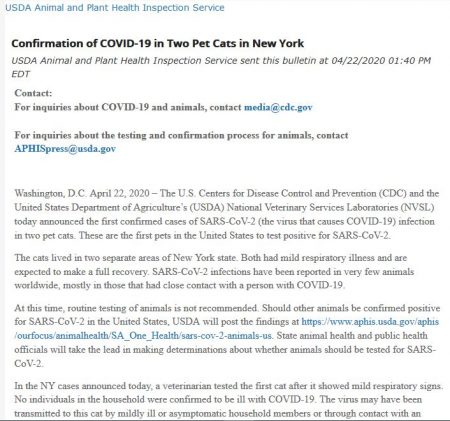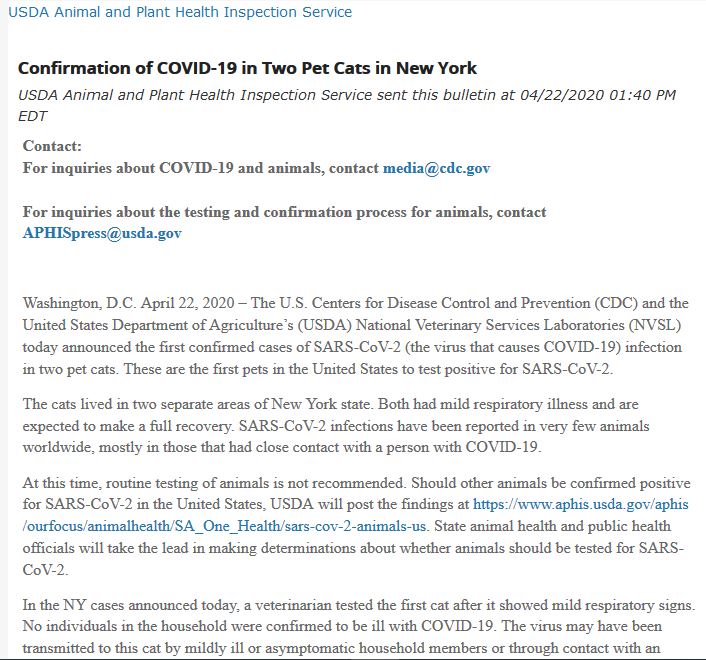ADDITIONAL EVIDENCE OF HUMAN-TO-ANIMAL TRANSMISSION
by Sharon Rondeau

(Apr. 22, 2020) — A press release early Wednesday afternoon announced the discovery by the U.S. Department of Agriculture (USDA) and the Centers for Disease Control and Prevention (CDC) of the virus which causes COVID-19 in two domestic cats residing in different parts of New York State.
The USDA’s Animal and Plant Health Inspection Service (APHIS)’s press release begins:
The U.S. Centers for Disease Control and Prevention (CDC) and the United States Department of Agriculture’s (USDA) National Veterinary Services Laboratories (NVSL) today announced the first confirmed cases of SARS-CoV-2 (the virus that causes COVID-19) infection in two pet cats. These are the first pets in the United States to test positive for SARS-CoV-2.
“The cats lived in two separate areas of New York state,” the press release continues. “Both had mild respiratory illness and are expected to make a full recovery. SARS-CoV-2 infections have been reported in very few animals worldwide, mostly in those that had close contact with a person with COVID-19.”
In one case, APHIS reports, “No individuals in the household were confirmed to be ill with COVID-19.” In the second, however, “The owner of the cat tested positive for COVID-19 prior to the cat showing signs” and “Another cat in the household has shown no signs of illness.”
On April 5, APHIS reported that a tiger, said by the Wildlife Conservation Society to reside at the Bronx Zoo, tested “positive” for the virus after it and several of its feline companions “showed symptoms of respiratory illness.”
As with the pet cats, the tigers and lions experiencing the symptoms were “expected to recover.”
According to the April 5 press release, the larger animals require general anesthesia to be tested for COVID-19. The Post & Email inquired of APHIS as to the procedure for testing domestic cats but did not receive a response as of press time.
“Public health officials are still learning about SARS-CoV-2, but there is no evidence that pets play a role in spreading the virus in the United States,” the APHIS bulletin further states.
The World Health Organization (WHO), from which President Trump temporarily suspended U.S. funding last week pending the outcome of a congressional investigation into the group’s response to the initial outbreak of COVID-19 in China and its spread to other countries, has said that the coronavirus appears to be related to a number of similar viruses found in bats whose natural habitat is southern China. In February, the WHO contended that as to its spread from bats to humans, “The current most likely hypothesis is that an intermediary host animal has played a role in the transmission.”
U.S. sources, however, suggest that the origin of the deadly virus is a Wuhan laboratory where the study of animal viruses, and specifically those residing in bats, was taking place.
On Tuesday, U.S. Senator from Arkansas Tom Cotton wrote a column in The Wall Street Journal which begins:
The U.S. government is investigating whether the Covid-19 virus came from a government laboratory in Wuhan, China. The Chinese Communist Party denies the possibility. “There is no way this virus came from us,” claimed Yuan Zhiming over the weekend. Mr. Yuan is a top researcher at the Wuhan Institute of Virology, which studies some of the world’s deadliest pathogens. He is also secretary of the lab’s Communist Party committee. He accuses me of “deliberately trying to mislead people” for suggesting his laboratory as a possible origin for the pandemic.
Since late January, Cotton has publicly contended that the coronavirus may not have originated at a Wuhan food market as is commonly reported. Cotton’s suggestion that the virus originated in the Wuhan laboratory has been termed a “debunked conspiracy theory” by left-leaning “media” similar to other hot-button issues.
According to CNBC, the WHO continues to report that the coronavirus “originated in bats in China in late 2019 and was not made in a laboratory.”
Update, 5:49 p.m. EDT: A response received from Lyndsay Cole, Assistant Director, Public Affairs, USDA Animal and Plant Health Inspection Service states:
No, companion animals do not have to be put under anesthesia for samples to be collected. Samples should be collected at the direction of state animal health and public health officials. Information about how samples should be collected is available in the following FAQ document for animal health and public health officials: https://www.aphis.usda.gov/

